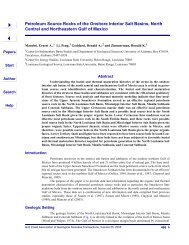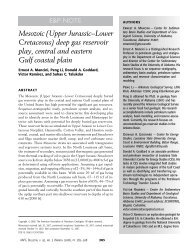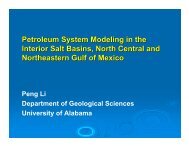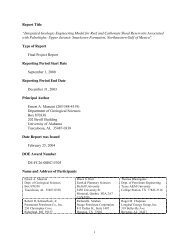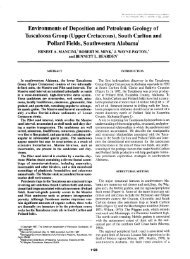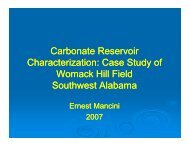Part 4 - Berg - Hughes Center
Part 4 - Berg - Hughes Center
Part 4 - Berg - Hughes Center
You also want an ePaper? Increase the reach of your titles
YUMPU automatically turns print PDFs into web optimized ePapers that Google loves.
northern Louisiana. Dickinson stated that the lower member of the Buckner is time-<br />
equivalent to part of the upper member of the Smackover, but the upper Buckner grades<br />
basinward into the Bossier Formation. The Buckner calcarenite zones coalesce at the<br />
south edge of the Haynesville field to form a bank up to 600 ft thick, which extends<br />
regionally along the basinward edge of the shelf slope, a zone of active subsidence.<br />
Dickinson (1969) stated that the older zones of the Buckner calcarenite appear to be<br />
limited to the south flanks of Haynesville and Red Rock fields, and that the "A" zone is<br />
developed on a regional scale across North Louisiana and is known to extend from Texas<br />
nearly to Mississippi. The trends vary from east to west to northwest, with a beach<br />
deposit forming at the seaward edge of the shelf-slope break during the Buckner<br />
regression.<br />
In summary, the Haynesville-Buckner consists of fine-grained sandstones, shales,<br />
bedded anhydrite, and oolitic limestone that were deposited in a shallow marine<br />
environment. Hydrocarbons were primarily sourced from the underlying Smackover<br />
Formation basinal deposits and are stratigraphically trapped in multiple, stacked, ooid<br />
shoal pinch-outs. With respect to the reservoirs, the depth to top of pay is from 9,400 to<br />
10,750 ft. Porosity ranges from 9 to 16% and permeability from 50 to 400 md. Produced<br />
hydrocarbons consist of 42º API gravity oil, condensate, and gas.<br />
Upper Jurassic (Cotton Valley)<br />
Cotton Valley Group<br />
Producing Parishes<br />
355




